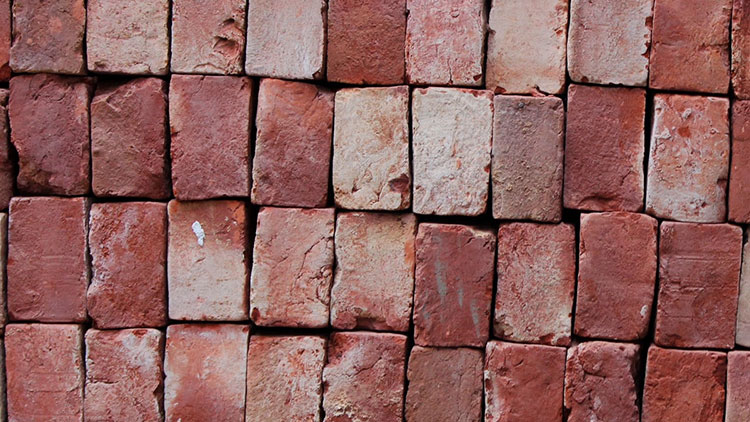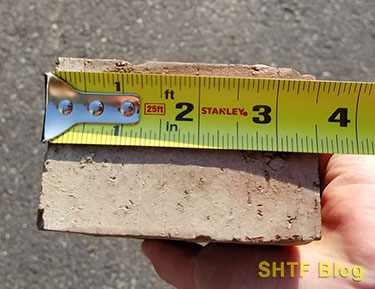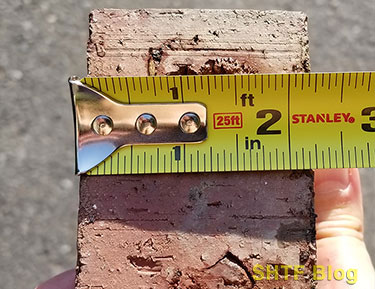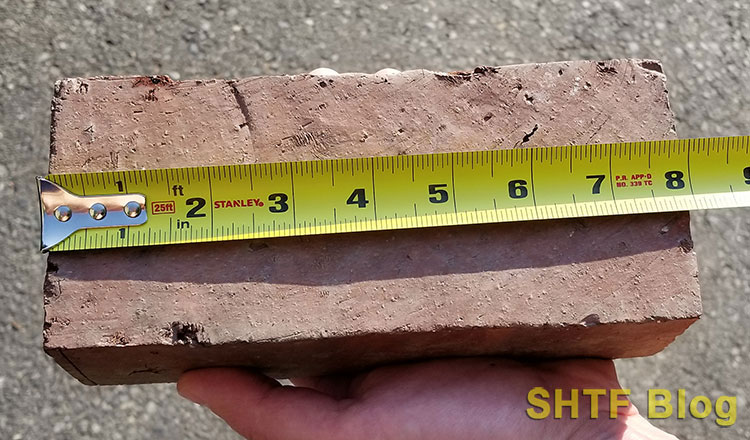
Despite masonry standards, you will rarely find a stack of bricks that all weigh the same individually. This is why you must use average brick weights.
Bricks have been used for in construction millennia. The earliest bricks, much like many of today’s bricks, were made of clay. In some cases, they were made from mud and straw. The Industrial Revolution brought about mass use of bricks in construction, however. By the early 1900s brick had become the preferred material for commercial buildings (source).
Much like the average weights of different concrete blocks, bricks will vary in weight depending not just on the physical dimensions but by density variations in bricks of the same size.
What is the Most Common Brick Size?
According to The Brick Industry Association research, the most common brick size is 3 1/2″ x 2 1/4″ x 7 5/8″. When people think of a “brick,” this is the size they picture; rectangular in shape that fits in your hand.



This is a general guideline, however. Few people will notice the difference between that size and what Home Depot, as an example, would sell as a common concrete brick: 7 3/4″ x 2 1/14″ x 3 3/4″.
How Much Does a Brick Weigh?
Asking “What does a brick weigh?” is about like asking “What does a person weigh?” It depends entirely on the type of brick. There are will over 100 different types of “bricks.”
There are burnt clay bricks, engineering bricks, pavers, hollow bricks, solid bricks, and on and on. Weight matters, however, either for building construction, for carrying them, or for hauling them in a vehicle. If you’re going for a load of bricks, you want to know what your truck can carry!
What is the Average Weight of a Red Brick?
Ah, the ubiquitous red brick, turning red in color after entering the oven. The high clay content colors to a reddish-rust color with the heat. These bricks can be dyed different colors in the manufacturing process, but the red brick is what most people envision with the word “brick.”
The average weight of a common red brick is about 4.5 pounds. That’s 2.04 kilograms or 2,041 grams.
Using that average weight, 444.44 bricks equals 1 ton. If you figure the typical pallet will hold 500 bricks of this size, one pallet of bricks will weight 2,250 pounds.
These are averages, however. As noted, differences in construction can account for slightly differing weights between bricks. See this brick as an example:

The pitted side of this brick I photographed can explain slight differences in weights between bricks of the same dimensions. If the construction is poor, the interior of this brick could be similar, creating air pockets where less clay material would otherwise be.
Average Brick Weights in Different Sizes
Now that we understand slight differences in weight, we can move toward “average” weights. For this purpose, we’ll use Belden Brick specifications for reference:
| Brick Type | Dimensions | Average Weight |
|---|---|---|
| Modular | 3-5/8″ x 2-1/4″ x 7-5/8″ | 4.2 lbs (1.9 kg) |
| Standard | 3-5/8″ x 2-1/4″ x 8″ | 4.5 lbs (2.04 kg) |
| Jumbo Modular | 3-5/8″ x 2-3/4″ x 7-5/8″ | 5.1 lbs (2.31 kg) |
| Jumbo Standard | 3-5/8″ x 2-3/4″ x 8″ | 5.9 lbs (2.68 kg) |
| Slim Jumbo Modular | 3-1/8″ x 2-3/4″ x 7-5/8″ | 4.1 lbs (1.86 kg) |
| Queen | 3-1/8″ x 2-3/4″ x 9-5/8″ | 5.6 lbs (2.54 kg) |
| Roman | 3-5/8″ x 1-5/8″ x 11-5/8″ | 4.7 lbs (2.13 kg) |
| Norman | 3-5/8″ x 2-1/4″ x 11-5/8″ | 6.5 lbs (2.95 kg) |
| Jumbo Norman | 3-5/8″ x 2-3/4″ x 11-5/8″ | 6.4 lbs (2.9 kg) |
| Modular Economo | 3-5/8″ x 3-5/8″ x 7-5/8″ | 6.8 lbs (3.08 kg) |
| Utility | 3-5/8″ x 3-5/8″ x 11-5/8″ | 10.2 lbs (4.63 kg) |
| Monarch | 3-5/8″ x 3-5/8″ x 15-5/8″ | 12.5 lbs (5.67 kg) |
| Quad | 3-5/8″ x 7-5/8″ x 7-5/8″ | 14.1 lbs (6.4 kg) |
| Ambassador | 3-5/8″ x 2-1/4″ x 15-5/8″ | 8.8 lbs (4 kg) |
| Double Utility | 3-5/8″ x 7-5/8″ x 11-5/8″ | 21 lbs (9.53 kg) |
| Double Monarch | 3-5/8″ x 7-5/8″ x 15-5/8″ | 25.5 lbs (11.57 kg) |
You may find different manufacturers list different weights, but these weights will work for most purposes.
Further Reading
I hope these average brick weights will help inform your project building. Ready to take your bricks and put them to use? Consider the following books:
- Black & Decker The Complete Guide to Concrete & Masonry – by Editors of Cool Springs Press
- Building with Masonry: Brick, Block & Concrete / For Pros by Pros – by Richard Kreh
- Cinder Block Gardens – by Lynn Gillespie
- The Complete Guide to Home Masonry: Step-by-Step Projects & Repairs Using Concrete, Brick, Block & Stone – by Editors of Creative Publishing
If you’re here reading this article, tell us what you’re planning to use bricks for in the comments section below!
(Feature photo by Ansh Bhagania on Unsplash. Decorative brick photo by Vecteezy.)
